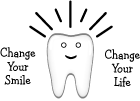Brushing and Flossing in Braces
Braces are a tricky thing. Brushing and flossing can be a challenge for braces wearers. We’re here to tell you that it is possible to keep your teeth and gums clean and healthy while wearing them, so don’t worry!
You need a soft toothbrush to handle the job firmly but gently. Angle your toothbrush at 45 degrees to the tooth and then 45 degrees from each surface of the bracket or the top, right, left, and bottom sides. You’ll need to use quick, small strokes and continue on each tooth individually.
We recommend a minimum of two minutes of brushing, but highly suggest brushing longer for a more thorough effect.
A high-quality electric toothbrush can also help with the tough job. An electric toothbrush can ease the strain on your hand and arm as you brush for a longer period of time. It can also ensure the small movements needed to work around each bracket without much effort on your part. Some toothbrushes come with special heads built for braces, so check it out!
You’re done brushing, but you’re not done yet! Don’t forget to floss. Your teeth are moving, so now more than ever is it important to get between them and eliminate food particles. They make floss threaders specifically for those with braces, dental bridges or permanent retainers and it will make the job much easier.
To use a floss threader, pull off 18 inches of your dental floss. Insert the single end of the floss threader between the wire and the gap where two teeth meet. Slide the end of your floss through the loop. Pull the end of the floss threader upwards so that you can grab the floss above the wire. Now you can floss freely!
Another option for getting in between teeth is to use interproximal brushes. These have a nice long handle to grip and a narrow brush tip that can be inserted between teeth. If you’ve got very small spaces between your teeth you’ll want to get the smallest brush heads available. If you have larger spaces, go for a larger brush head. Just push the brush between your teeth and gently rotate the brush, moving it in and out of the space.
Our goal with regular brushing and flossing two to three times a day is to prevent decalcification. This is where plaque left on the tooth will allow bacteria to grow and begin breaking down the enamel. It leaves white spots behind to be found when the braces come off, so we want to avoid this at all cost.
If you’re in braces, be sure to discuss your dental hygiene with us regularly to stay on top of your oral health. We want to bring out your best smile before, during, and after braces!

